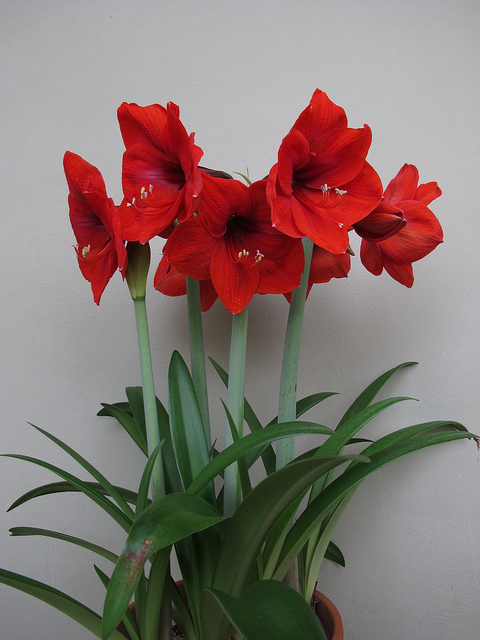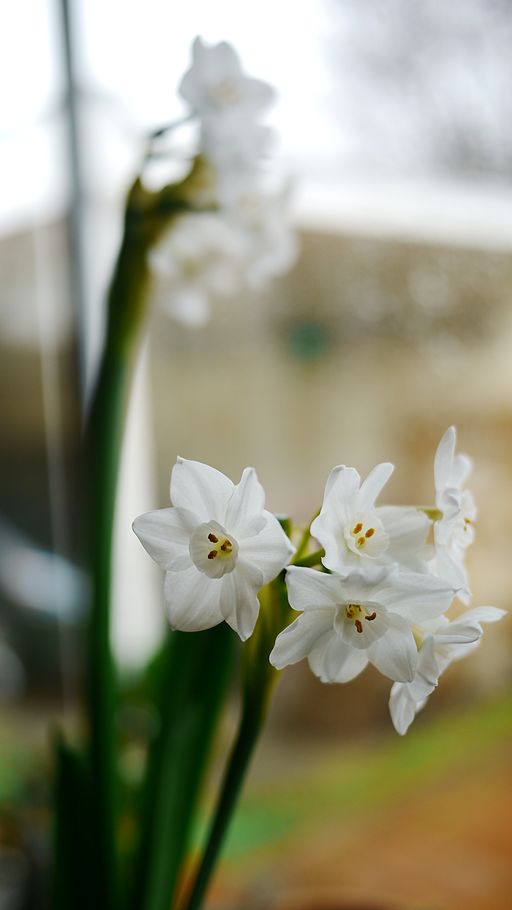This month’s article features two plants:
Scientific name: Hippeastrum
Common name: amaryllis
Family: Amaryllidaceae
Scientific name: Narcissus papyraceus
Common name: paperwhite
Family: Amaryllidaceae
Article by Jeanne Gozigian
“Forcing” bulbs for winter indoor floral beauty can be a fun and easy project when outdoor gardening is under a layer of snow and all is a dreary brown in our region. Unfortunately, if we are looking for holiday season color from most bulbs, we needed to start in September or October, because most bulbs require a fairly strict regimen to “force” them to bloom out of season. But – it is not too late to think of lovely “paperwhite” narcissus or the brilliant colors of amaryllises. They require no strict regimen.
![By terren in Virginia (Flickr: Paperwhites) [CC BY 2.0 (http://creativecommons.org/licenses/by/2.0)], via Wikimedia Commons](https://santafebotanicalgarden.org/wp-content/uploads/Paperwhites.jpg)
By terren in Virginia (Flickr: Paperwhites) [CC BY 2.0 (http://creativecommons.org/licenses/by/2.0)], via Wikimedia Commons
Often sold at holiday time, paperwhites and “amaryllises” are so much easier. All that is needed is a shallow dish, bowl or bulb vase. Fill the container ¾ full of gravel, pebbles, or glass beads, being sure to rinse the filling material thoroughly. The bulbs should be placed root side down, with filler in between to stabilize the bulbs. Add water to just cover the root systems. It is best to keep the bulbs at cool temperatures of 50-65 degrees Fahrenheit and in indirect lighting. Of course, they must never be allowed to dry out, so watch the water level in the containers. They can also be successfully grown in potting soil but it is interesting to see the root growth in the water -based medium.

Hippeastrum ‘Red Lion’. Photo: Scott Zona.
The “amaryllises” that we use for forcing are really in the genus Hippeastrum. This is a case where common names can lead one astray; another similar example is with the plants we know as tender or summer geraniums (and scented geraniums) that are properly in the genus Pelargonium; however, our hardy perennial geraniums are rightly Geranium. Confused yet? There is a genus Amaryllis, that has but one species, Amaryllis belladonna, that hails from South Africa and is beautiful, but it is exceedingly difficult to bloom in a pot. It is best grown in California, with a mediterranean climate like South Africa. They are known as “Naked Ladies”, because they bloom in the fall on “naked” stems well before any foliage growth begins.
OK, back to the “amaryllis”, Hippeastrum, that we CAN force. There are 70-90 species of Hippeastrum native to the Caribbean, Central and South America. They hail from warm climates, and thus need no strict chilling. There are over 600 hybrids and cultivars, in an incredible range of colors. The name comes from “hippeus”, which means horseman or knight. A common name is Knight’s- star-lily, another misnomer, here the bloom was mistaken for a true lily from the genus Lilium. The “amaryllis” bulbs sold at holiday time have been specially handled, or “treated”, to initiate growth as soon as they are planted. Untreated bulbs can be grown in very temperate climates, as in USDA zone 8 or warmer, where they are planted out in late winter to bloom in late spring. After you force your treated holiday “amaryllis” (grown in potting soil, not forced in water!) they can be placed outside after danger of frost and grown on, but they need good fertilizing, and will want to go dormant quite late in the fall. Also, now “untreated”, they will then initiate growth in spring the following year; they will not bloom in the dead of winter.
 Like “amaryllises”, paperwhites are monocots. Paperwhites, like our beloved daffodils, are in the genus Narcissus. The narcissus that we force in water is Narcissus papyraceus, taking its name from “papyrus” and “-aceus” – meaning, “paper-like”. They are native to the western Mediterranean where winters are exceptionally mild, thus they require no chilling period. Several strongly fragrant, small white flowers top each 1-1.5 ft. stem and will bloom in 3-4 weeks after starting. Cool temperatures and indirect lighting are best for paperwhites to prolong the bloom. In a warm room, some find the cloying fragrance overwhelming. The cultivar ‘Ziva’ has become most popular and is simple to force, but the cultivar ‘Inbal’, available from Brent and Becky’s bulbs, has a more delicate fragrance. However, it must be grown in potting soil- it doesn’t adapt to forcing in water.
Like “amaryllises”, paperwhites are monocots. Paperwhites, like our beloved daffodils, are in the genus Narcissus. The narcissus that we force in water is Narcissus papyraceus, taking its name from “papyrus” and “-aceus” – meaning, “paper-like”. They are native to the western Mediterranean where winters are exceptionally mild, thus they require no chilling period. Several strongly fragrant, small white flowers top each 1-1.5 ft. stem and will bloom in 3-4 weeks after starting. Cool temperatures and indirect lighting are best for paperwhites to prolong the bloom. In a warm room, some find the cloying fragrance overwhelming. The cultivar ‘Ziva’ has become most popular and is simple to force, but the cultivar ‘Inbal’, available from Brent and Becky’s bulbs, has a more delicate fragrance. However, it must be grown in potting soil- it doesn’t adapt to forcing in water.
As I write this article in October, my paperwhite and amaryllis bulbs are on their way to me. I have grown them in the past and I look forward to doing it again for fun winter gardening. Why don’t you get in on the fun?
Thanks to Janice Tucker and Helen Woody for proofreading this article.
Sources:
Royal Horticultural Society: Rhs.org.uk/advice profile?PID=102
Wikipedia
Pacific Bulb Society: www.pacificbulbsociety.org
Bulbs from:
Jacksonandperkins.com
Amazon.com


